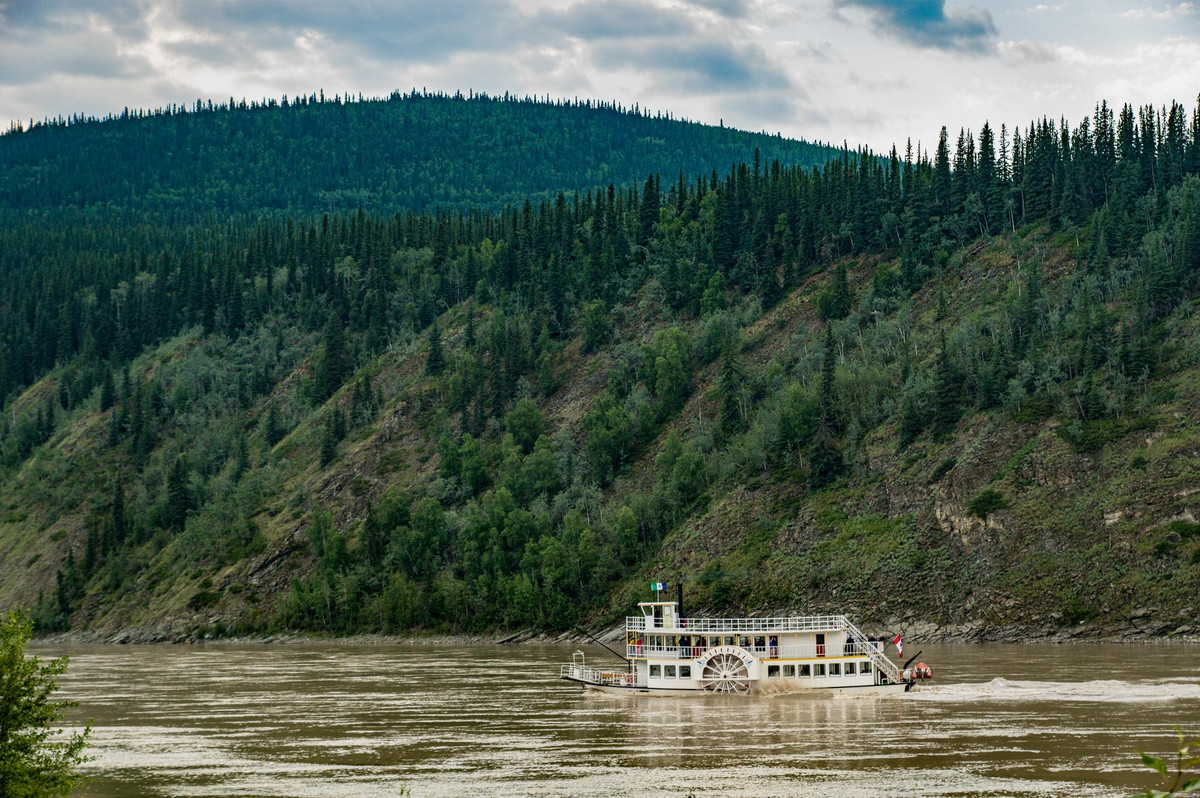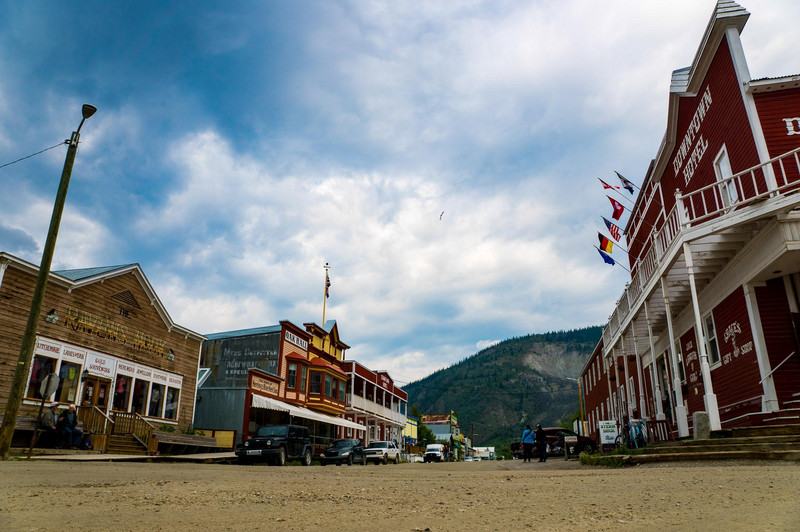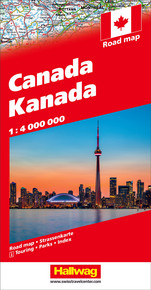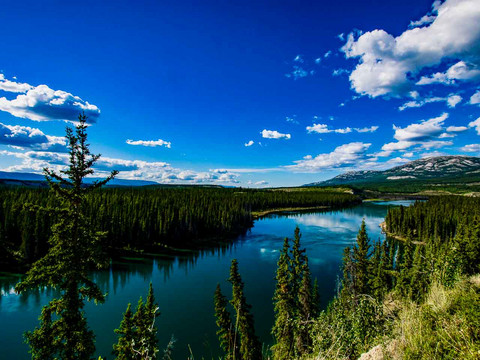Camping in the national park, whale watching, bear watching, hiking to glacier fields. Canada's Yukon province and the southeast of the US state of Alaska stand for breathtaking landscapes and adventure at the same time. The unique combination of mountains, glaciers, lakes, rivers, rugged coastline and pristine national parks make Alaska and Yukon my favourite destinations of all. Experience bears, moose, caribou and whales in their natural environment. Whether by canoe, on a hike or panning for gold, there is much to experience and discover.
Few destinations stand for adventure and pure wilderness as much as the great, unknown north of the American continent. Statistically, there is less than half a person per square kilometre in Alaska, and even fewer in Canada's Yukon. America's "last frontier" is vast, wild, empty and therefore ideal for an extended road trip with a camper through the seemingly endless landscapes. The highways are mostly dead straight through endless forests and mountains, long and sparsely travelled. As for the best time to travel: "Alaska also has four seasons: June, July, August and winter" - as the saying goes, and this already answers the question about the best time for a road trip. The first half of September is also a good time. It's a bit cooler then, but that also means fewer forest fires, hardly any mosquitoes and good chances of seeing the Indian summer. The choice of travel routes is limited due to the few highways. The classic is the lying eight, which I presented in another report and passes all accessible and worth seeing places in Alaska and the Yukon. Today I take you on the "normal zero", a round trip with start and finish in Whitehorse.

After a ten-hour flight, you land in Whitehorse, the capital of the Yukon Territory. Welcome to "Canadas True North" as the true north of Canada likes to call itself. The province is larger than Germany, Belgium, Denmark and Switzerland combined. Today, 25'000 people live in the capital, about three quarters of the entire population of the Yukon. The charm of the small town, which lies on the Yukon River, is above all its beautiful surroundings. Whitehorse became famous beyond its borders because of the toughest dog sled race in the world, the "Yukon Quest", which takes place every year in February - and because of the gold rush a little more than 100 years ago. Witness to this time is the SS Klondike, which lies on the banks of the Yukon River. Built in 1929, the paddle steamer invites visitors to a museum today. During the gold rush, the ship took 36 hours to travel from Whitehorse to Dawson City, 720 kilometres further north. Today, you can make the Klondike Highway on wheels and without detours in a good six hours. Every day, the steamer transported passengers who had made it from Skagway to Whitehorse, along with their luggage and provisions, to the gold-mining towns. Only those who could afford it booked a trip on the ship. However, it was not without danger. The Yukon is full of rapids, gravel bars and boulders. One example is the famous "Five Finger Rapids" a few kilometres from Carmacks. Five huge basalt rocks divide the Yukon River into five fingers. The rapids have been the undoing of several ships that have sunk or leaked here.


When you arrive in Dawson City, the first thing you could do is get an overview. There's no better place to do that than on the lookout mountain Midnight Dome. In the days of the Klondike Gold Rush, this sleepy nest was a boomtown with over 40,000 inhabitants. A San Francisco of the North with posh hotels, restaurants and dance halls. People partied day and night. The saloons and gambling halls were open all day. Today Dawson City is a dreamy museum town. Gold is still mined around the second-largest town in the Yukon, with a population of about 1,400. More lucrative, however, is the business with tourists who are drawn to this remote place. Everything here looks like a natural open-air museum: unpaved streets, authentically restored house facades, an anchored paddle steamer named SS Keno and, of course, pavements made of wood. At Bonanza Creek and its road you can once again dive into the past of the gold rush. Every piece of earth around Dawson was dug up - here too. At the end of the road is one of the largest and probably most famous dredges used in the Yukon: Dredge No.4. At peak times, the dredge produced more than 800 ounces of gold in a single day. Not far from the historic site, you can try your luck yourself: In the "Claim 33 Goldpanning & Jerry Bryde Museum" you can become a little gold prospector yourself, including instruction in the technique of gold panning. A gold find is guaranteed! In the evening, the best way to end the day is to go to the casino and see the show of the "Diamond Tooth Gerties" - colourfully dressed cancan dancers swinging their naked legs.

Over the unpaved "Top of the World" Highway, a jewel for road trip fans, we cross over to Alaska. Nevertheless, driving on Alaska's roads should not be imagined as a firework display of exciting experiences: Often you see nothing for hours except endless taiga forest that passes monotonously by the car window. Seat leather and a good playlist are a must for driving. If you're lucky, you might spot a lone wolf or even a bear, sometimes caribou on the road prevent you from driving on. Once in Tok, we head south and back to Canada. The obligatory customs procedure with forms, fingerprints and a photo is quickly completed. After two more hours of driving on the Alaska Highway, we reach Kluane National Park and its lake of the same name. The largest lake in the Yukon virtually glows in the sunlight and owes its turquoise blue colour to a glacier. On the shores of the lake you can admire the pink willowherbs, known in North America as "fireweed". On "Sheep Mountain", with a bit of luck, you can watch Dall sheep from the roadside. Large parts of the Kluane National Park are UNESCO World Heritage Sites. Mount Logan, Canada's highest mountain, towers over the inaccessible hinterland. With an altitude of 6000 metres, it is only slightly smaller than its brother in Alaska, Denali. In three hours you reach Haines and find yourself in Alaska again.


Southeast Alaska, detached from the rest of Alaska - also called the Panhandle - impresses with glaciers, fjords and rainforests of enormous dimensions - southern Alaska is a natural paradise of superlatives. The best way to explore the rugged island kingdom is by ship. Ferries on the Alaska Marine Highway also transport campers. This way you can soak up the beauty of this region, also known as the "Inside Passage", from water and land. The sea is teeming with wildlife: you are likely to encounter dolphins and humpback whales, but also orcas, sea otters and seals. The majestic bald eagles soar through the skies and bears live on land. Both of the latter are almost 100% certain to be seen in sleepy Haines. During salmon season, the fish migrate up the Chilkoot River. No wonder the Haines area is a paradise for bears and bald eagles.

Juneau, the remote capital of Alaska, lies at the foot of the 1,164 m high Mount Roberts, embedded in picturesque nature. Glaciers, mountains, the forest of the Tongass National Forest and, of course, the sea await outdoor fans here. Although Juneau is located on the North American mainland, the city is the only capital of the US states that can only be reached by boat or plane. Juneau's biggest attraction is the famous Mendenhall Glacier, just 20 kilometres from the city centre. What capital city can claim to have a huge glacier on its doorstep?! It's great for hiking and kayaking. A trip by cable car to Mount Roberts is worthwhile on a clear day, as are whale-watching boat trips to Auke Bay. Popular and recommendable, but not quite cheap, are excursions by seaplane to the nearby nature reserves Chichagof Island or Admiralty Island to observe bears. Of course, you can also just take a relaxed stroll through the centre and see the sights of Juneau. These certainly include the Alaska State Capitol, the Russian Orthodox Saint Nicholas Church and the Alaska State Museum. South Franklin Street is beautiful with its historic 19th-century houses, which today house souvenir shops, restaurants and cafés.



The only way back to the Yukon and Whitehorse is by boat. In Skagway, the gold rush comes full circle. At the end of the 19th century, when the first stories about fabulous gold discoveries on the Klondike River made the rounds, thousands of gold seekers and adventurers travelled by ship through the Inside Passage to Skagway. From there, they made the arduous journey over White Pass and Chilkoot Pass to the goldfields on the Klondike River. Within a few weeks, Skagway's population swelled from a few hundred to 20,000. Today, the town exudes the charm of a museum village, making it a popular destination for tourists from all over the world. Campers, individual tourists as well as cruisers come to Skagway to soak up a little gold-digger atmosphere. Numerous jewellers, souvenir dealers and restaurants await customers in the historic buildings. In 1898, a locomotive was put under steam for the first time in this small harbour town to bring gold seekers to the Yukon. Today, a museum railway rattles up the mountain to Carcross. Here, a short photo stop at Canada's only desert is worthwhile. The 260-hectare Carcross Desert lies directly on the South Klondike Highway and is often called the world's smallest desert. The sand dunes are the last remnants of a glacial lake from the Ice Age. And another stop before Whitehorse is worthwhile at Emerald Lake, whose brilliant colour catches your eye from afar. The turquoise-green colour, created by deposited limestone and reflected by the sunlight, is unique. Together with the Gray Ridge Mountain range in the background, this makes for a dreamlike landscape panorama and a worthy conclusion to a very special trip.

To properly prepare for your trip
How to get there:
With Air Canada via Vancouver to Whitehorse
How to get around:
Motorhome at will at www.camperdays.de
How long to go:
3 to 4 weeks
Best time to travel:
Summer months
Highlights:
Gold mining towns of Dawson City & Skagway, bears on the Chilkoot River, Mendenhall Glacier, whales in Auke Bay.
Realised by Michael Bachmann
Further travel pictures under www.kissed-by-nature.com




























